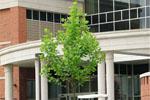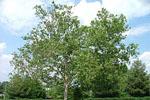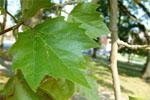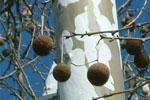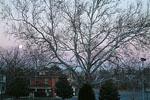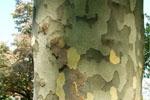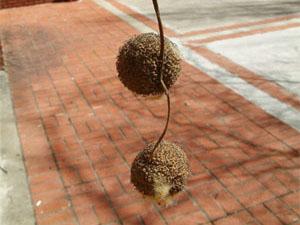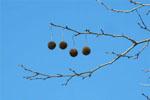Featured Tree Species
Sycamore (Platanus occidentalis)
Our native Sycamore is a common yet distinctive sight in both natural and planted landscapes. It's bark— a “camouflage” pattern of peeling patches, like tan, gray and brown puzzle pieces—eventually turns to a smooth white on the mature trunk and branches. Sycamores often grow in the sandy soils along streams and rivers. They can grow into massive trees, with towering white trunks visible from afar, and stand out brightly in the leafless winter landscape. Sycamores hold the record for the broadest trunk of a native tree: over ten feet in diameter at four feet above the ground. Along riversides one may see old trees with hollow trunks, caused by canker and wood-decaying organisms, providing animal dens or playhouses. Sycamores grow quickly and can live for hundreds of years. They bear large, stiff leaves resembling maples in shape, and make excellent shade trees for urban settings.
The American Sycamore is native to the eastern and central United States, occurring in all states east of the great plains except for Minnesota, and also in the mountains of northeastern Mexico. It’s botanical name, Platanus occidentalis, derives from “platy,” Greek for broad, and “occidere,” Latin for “to set, as in the sun,” meaning of the west. An old world species, Platanus orientalis (orientalis, Latin for “rising” or of the east), occurs from Asia Minor to the Himalayas. Hybrids between these two species are known as the London Plane Tree, (Platanus x. acerifolia or Platanus. x hispanica). These hybrids are the most common street tree in major European cities like Amsterdam, Barcelona, Paris, and Hamburg. The London Plane tree is highly tolerant of urban pollution, can be cut back or coppiced repeatedly, and provides good shade for city streets and sidewalks.
A common name for our native Sycamore is Buttonwood tree, referring to the fruits, which grow in one-inch balls hanging from stringy three to six inch stalks. The seed balls hang on the Sycamore all winter, then fall apart in early spring to disperse their many small seeds, leaving a hard, button-like core where the seeds were attached. Tufts of hairs on each seed act as parachutes, scattering seeds widely. The seeds are also eaten by birds and carried by water. The seed ball developed from the head of female flowers which formed in the previous year. Male flowers are also grouped in heads or spheres. Both male and female flower clusters occur on a the same individual, so the tree is “monoecious.” Look for these inconspicuous inflorescences in mid-spring. The American Sycamore bears its seed balls singly on each stringy stalk. The oriental plane tree produces three or more seed balls on each hanging stalk. The hybrid London Plane tree typically bears two to three balls per stalk.
There are seventeen American Sycamore trees growing on the ETSU campus. A group of fairly mature Sycamore trees grows along Gilbreath Drive between Gilbreath Hall and the University School. The line of newly planted Sycamores or London Plane trees is planted in front of the new Center for Physical Activities. Tall Sycamore trees can be seen growing alongside the duck pond at the Veterans Administration Mountain Home campus. In winter it is very easy to spot native Sycamores at a distance or from the car window, growing along streams and in bottomlands. The ETSU Arboretum has one young specimen of the oriental plane tree Platanus orientalis, planted in 2003 on the north side of Gilbreath Hall.
Sycamore trees can be bought from some local nurseries, such as Evergreen of Johnson City, which sells five foot trees in five gallon pots for about $40. They are occasionally available from outlets like Lowe's and Home Depot. Because our native sycamore is susceptible to leaf blight from spring anthracnose disease, tree experts recommend growing resistant hybrid cultivars such as ‘Columbia’ or ‘Bloodgood.’ A specimen of the attractive variety ‘Columbia,’ selected by the National Arboretum, is planted at ETSU just northeast of Gilbreath Hall. The cultivars mentioned above are available from mail-order nurseries such as Forest Farm (www.forestfarm.com) , for about $15 to $50 in one and five gallon pots.
While sycamores make magnificent, fast-growing shade trees, a couple down-sides warrant note. The large leaves make for autumn raking work. Also, the fuzzy brown stellate (star-like) hairs on the young leaves and stems can be irritating to the skin and eyes, especially in late spring when this pubescence is shed from the leaves.
Recommended Web Links
 Stout Drive Road Closure
Stout Drive Road Closure 